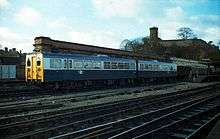British Rail Class 140
| British Rail Class 140 Pacer | |
|---|---|
|
140001 (right) at Landore TMD, Swansea in 1982. | |
| In service | 1980 - 1981 (trial only) |
| Manufacturer | BREL |
| Order number | 30962[1] |
| Built at | Derby Litchurch Lane[1] |
| Family name | Pacer |
| Number built | 1 |
| Formation |
|
| Diagram |
|
| Fleet numbers |
|
| Capacity |
|
| Operator(s) | British Rail |
| Depot(s) | Neville Hill[1] |
| Specifications | |
| Car length | 16 m (52 ft)[1] |
| Width | 2.5 m (8 ft 2 in)[1] |
| Maximum speed | 75 mph (121 km/h) |
| Weight |
|
| Prime mover(s) | 1 × Leyland TL11 (per car)[2] |
| Power output | 205 hp (153 kW)[1] |
| Transmission | SCGR500 4-speed[2] |
| Safety system(s) | |
| Track gauge | 1,435 mm (4 ft 8 1⁄2 in) standard gauge |
The British Rail Class 140 was the prototype of the Pacer diesel multiple unit. Much of the bodywork was constructed using Leyland National bus components, with the exception of the cabs, between 1979 and 1981. The sole member of the class has been preserved and is at the Keith and Dufftown Railway.
Design
Based on the single car railbus prototypes, the class 140 was built to BR's then stringent regulations regarding crashworthiness and resistance to end loading in 1980. This meant that it lost its lightweight 'bus on a wagon' look and was much more substantial.
The original traction power train consisted of a Leyland TL11[3] 200 HP engine, a Self-Changing Gears mechanical automatic gearbox and a Gmeinder final drive unit on each car driving only one axle.
History
The unit was built between 1979 and 1981, had a press launch in June 1981, and then toured the UK for trials and as a demonstration unit.[4] During 1985, the unit was in use as a driver training vehicle.[4] From September 1986, the set was allocated to Neville Hill.[5] By 1994, prior to sale, the unit was kept at Neville Hill depot as a parts donor.[6]
Legacy
The Class 140 formed the basis of the design of the production Pacer sets of Class 141 introduced in 1984 and Class 142 introduced in 1985.
Preservation
The unit was purchased for preservation and collected from Leeds in February 1995.[7] The sole member of the class, 140001, formed of cars 55500+55501, has been preserved and is at the Keith and Dufftown Railway[8] This unit is at Dufftown Station. It is being restored to its former state by volunteers at the railway.

References
- 1 2 3 4 5 6 7 8 9 10 Fox 1987, p. 40
- 1 2 "Class 140". The Railway Centre. Archived from the original on 9 March 2005.
- ↑ Smith 2002, p. 7
- 1 2 Smith 2002, p. 3
- ↑ Knight, Steve (November 1986). "Class 140 moves to Eastern Region". Rail Enthusiast. No. 62. EMAP National Publications. p. 30. ISSN 0262-561X. OCLC 49957965.
- ↑ Smith 2002, pp. 3–4
- ↑ Smith 2002, pp. 4
- ↑ "The Keith and Dufftown Railway - Multiple Units".
Sources
- Fox, Peter (1987). Multiple Unit Pocket Book. British Railways Pocket Book No.2 (Summer/Autumn 1987 ed.). Platform 5 Publishing Ltd. ISBN 0906579740. OCLC 613347580.
- Smith, R.I. (2002). Class 140: The Past, The Present, The Future. Keith & Dufftown Railway Association. ISBN 0901845213.
Further reading
- Bellass, Eddie (December 1981 – January 1982). "'140' in the Highlands". Rail Enthusiast. EMAP National Publications. pp. 38–39. ISSN 0262-561X. OCLC 49957965.
- Haresnape, Brian (1986). Diesel Multiple-Units: The Second Generation and DEMUs. British Rail Fleet Survey. 9. Ian Allan. pp. 32–41. ISBN 9780711016040. OCLC 59997563.
- "'Pacer' prototype goes to Dufftown". RAIL. No. 339. EMAP Apex Publications. 9–22 September 1998. p. 59. ISSN 0953-4563. OCLC 49953699.
.jpg)